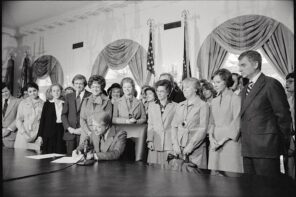Eight years ago here at RD I noted that women were fleeing organized religion—as measured by attendance at religious services—faster than men, a trend that showed no sign of letting up. Historically, women have been a good deal more likely to go to church than men, but by 2012 the gender gap had narrowed to just six points, its lowest level ever, with 28% of women and 22% of men saying they attended services at least weekly, according to the Pew Research Center.
But now in an historic reversal, political scientist Ryan Burge has shown that, at least for college-educated people, men are more likely to attend church than women. In 2008, 36% of college-educated women went to services at least weekly, versus 34% of men. As Burge notes, higher levels of education correlate with greater church attendance: that same year, 27% of men and 30% of women with a high school degree or less went to church.
But in 2012, something interesting happened—for the first time, the level of church attendance more or less evened out for college-educated men and women, with 31% of men and 32% of women going weekly. Notably, while both men and women were less likely to go to church than four years earlier, women’s attendance dropped slightly more.
But following that, men’s attendance held more or less steady, with the same 31% attendance in 2016, 30% in 2020 and 2022, and 32% in 2024. But women’s attendance declined precipitously, dropping five points between 2012 and 2020. Since then it’s been holding steady at 27%. Overall, women’s weekly attendance dropped nine points between 2008 and 2023, according to Burge, while men’s dropped a mere two points. So by 2023, college-educated men were five points more likely than college-educated women to attend religious services at least weekly.
What’s behind this reversal in religiosity? As I noted in 2008, women’s attendance had been dropping since the 1980s, about the time “religious leaders in the Catholic Church and the evangelical movement fused religion with the culture wars.”
It’s notable that men and women’s attendance equaled out in 2012. That was the year that the US Conference of Catholic Bishops (USCCB) launched its “religious liberty” drive against covering contraceptives in the Affordable Care Act, a campaign that soon drew support from evangelicals and resulted in the stunning Hobby Lobby decision to allow employers to deny birth control to women who work for them.
College-educated women’s church attendance dropped below men’s for the first time in 2016, the year that evangelicals cozied up to Donald Trump and the Catholic bishops actually helped spur him into office with fear mongering over religious liberty that drove many Catholics into the Trump camp.
By 2020 it had dropped another two points as a US Supreme Court, stacked with religious conservatives appointed by Trump, ruled on a broad swath of cases pushed by the Catholic bishops and evangelicals. They gave employers broad leeway to refuse to provide contraception, bakers the right to refuse services to same-sex couples, and anti-abortion pregnancy counseling centers the right to mislead women about the nature of their services.
It sure seems like the more churches talk about denying women and others bodily autonomy, stressing culture-war issues like abortion, LGBTQ rights, and contraception, and backing political actors who make it happen, the more that educated women, especially younger women, respond by walking out the door. After all, these issues affect them directly, while for men, including those who make the rules, these issues are political or theological, but not personal. It’s no coincidence, as Burge notes, that the drop in college-educated women’s church attendance largely parallels the increasing gender divide in partisan identification, as a “college educated woman is 10-12 points more likely to be a Democrat than a man at the same level of education.”
Like eight years ago, the trend shows little sign of abating. The Supreme Court’s reversal of Roe and subsequent horror stories about women being forced to carry dangerous or doomed pregnancies to term has only solidified for many women how little conservative religious leaders care about their lived reality. Last month, the Southern Baptist Convention voted to oppose the use of in vitro fertilization (IVF), a dramatic alignment with the moral theology of the Catholic Church. As Ruth Graham reported in the New York Times, this signals that evangelicals are “increasingly open to arguments that equate embryos with human life,” and may push for “fetal personhood” laws that ban all abortions.
And while Pope Francis has taken baby steps toward including women in the decision making of the Catholic Church, few in the pews have probably taken note, especially since bigger steps like allowing women to be deacons remain off the table. Meanwhile, a year out from the 2024 election, the Catholic bishops designated abortion the “preeminent priority” for Catholic voters in their quadrennial voting guide and doubled down on complementarianism, opposing “a gender ideology that fails to recognize the difference and reciprocity between man and woman.”
The bishops even instructed that excerpts from their voting guide be inserted into parish bulletins, where they increasingly seem to be preaching to a choir that is missing women’s voices.





